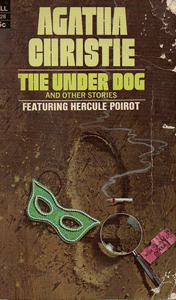Although published as a U.S. collection in 1951, “The Under Dog and Other Stories” takes us back to the early days of Poirot and Hastings’ adventures under the pen of Agatha Christie. Indeed, these stories (except for “The Under Dog” itself) were later collected in the U.K. under the apt title “Poirot’s Early Cases.”
Introducing Poirot
In these nine stories first published in magazines (mainly the U.K.’s The Sketch) from 1923-26, Christie establishes Hercule Poirot each time for a new reader. Narrator Captain Hastings, sharing lodgings with Poirot, observes his friend’s obsession with order and method.
Christie would later glean humor from Poirot’s proclivities, but it’s only lightly amusing here. Also, Poirot speaks French more than in later books, and Hastings often leads a reader into these stories by noting how unusual or interesting the case is.

“The Under Dog and Other Stories” (1951)
Author: Agatha Christie
Series: Hercule Poirot No. 31
Genre: Mystery short stories
Setting: London, 1923-26
These short stories emphasize the mystery, not the characters. People are pawns on the chess board that is the case. A good example of the difference between shorter and longer forms can be found by comparing the 16-page “The Submarine Plans” (1925) to its 55-page expansion “The Incredible Theft” (part of the “Dead Man’s Mirror” novella collection in 1937). The latter fleshes out the characters, but the core mystery plays just as well – perhaps better – in “The Submarine Plans.”
This story is also notable for Poirot’s surprising (and perhaps unwarranted) level of respect for British government officials. Perhaps this is a reflection of Christie’s nationalistic feelings in the wake of the Great War. It seems out of character for Poirot, who doesn’t generally dish out immediate respect based on a person’s title.
I’m a little surprised that “The Submarine Plans” was collected on its own, because everything here is also in “The Incredible Theft” (unless you count superficialities like the change from a submarine to an airplane bomber, and name changes). But it’s fun to have it for the sake of comparison and completion.
The winners
Another example of a strong mystery is “The King of Clubs” (1923), where a king left in the card box signals to Poirot what really happened, as opposed to what witnesses claim. “The Limesurier Inheritance” (1925) is engrossing as Christie plays a broad game of sleight of hand, distracting us with a family curse against first-born sons while Poirot calmly examines what’s really going on.
“The Adventure of the Clapham Cook” (1925) and “The Cornish Mystery” (1925) are quite strong, as the perpetrators smartly use the public’s expectations about certain things to fool everyone (except Poirot, naturally).
“The Market Basing Mystery” (1925) finds Poirot, Hastings and Japp vacationing together (a nice illustration of their friendship) when a seemingly impossible suicide catches their collective fancy. Although the yarn is engaging, the solution is simple enough that I felt the official investigators dropped the ball by not inquiring about a basic fact about the deceased.

The misfires
The other three fell flat for me. “The Plymouth Express” (1924) smartly emphasizes the way an unusual wardrobe can mislead witnesses, but Christie has written so many superior stories set in train cars that this early effort is underwhelming.
“The Affair at the Victory Ball” (1923) takes place at a masquerade dance, and frankly, it’s hard to follow. It’s apparent that people’s hidden identities will play a role in the trickery of whodunit, but Christie leaves me in the dust here.
Here’s a fun oddity: “Plymouth” and “Victory Ball” include editor’s notes that encourage the reader to pause and reflect on the clues so far, because from that point forward Poirot will unravel the case. I wonder if this was done because in a short story, you can’t see how many pages are left the way you can in a novel. Or it could be the editor’s attempt to spice up relatively weak tales.
If not for “Plymouth” and “Victory Ball,” title yarn “The Under Dog” (1926) — the book’s longest at 65 pages — would surprisingly rank at the bottom. It involves a house layout that’s hard to picture, relationships that are hard to pin down, and hypnotism that conveniently works. It’s long enough to include some character development, but too short for rich character development. And I didn’t understand all of Poirot’s actions.
In the early 1920s, Christie was still honing her craft. Some of these are harmless misfires; others indicate she’s on a path to becoming a master of the mystery-spinning game.
Every week, Sleuthing Sunday reviews an Agatha Christie book or adaptation. Click here to visit our Agatha Christie Zone.

